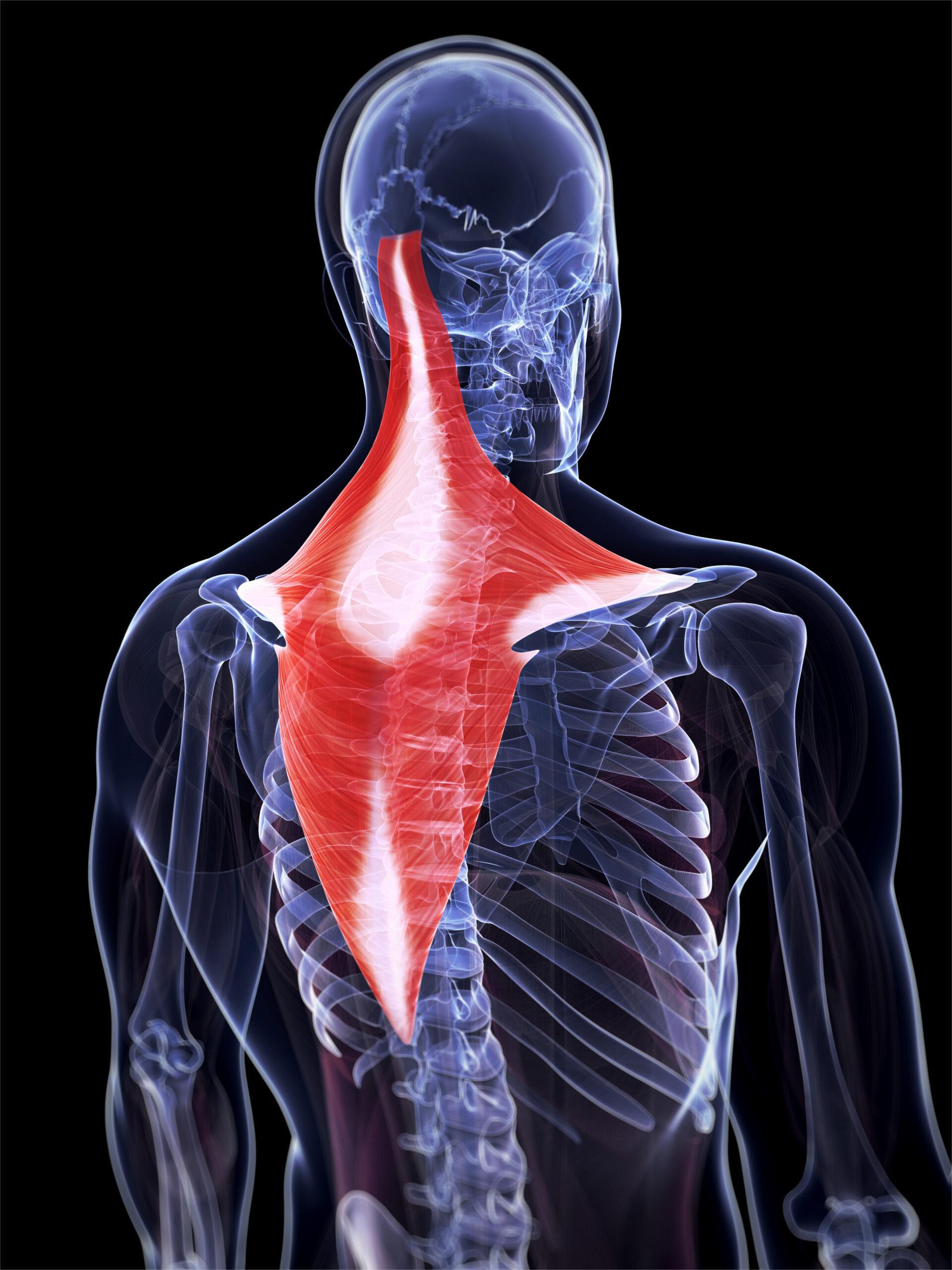Your trapezius is a large broad muscle spanning your upper back. It has attachments to your spine, shoulder blade, and collarbone. Your trapezius is divided into 3 parts: the upper, middle, and lower portions. As a whole, your trapezius plays an important role in overhead function. Your middle trapezius is also responsible for retracting or pulling back the shoulder blade. Poor function of your middle trapezius has been associated with shoulder, neck, and elbow pain. Thankfully, there are a variety of middle trapezius exercises that will decrease your pain and improve function.
The Role of Middle Trapezius Exercises in Overhead Sports
Your middle trapezius plays an important role in positioning and controlling the movement of your arm during overhead sports. This is especially true in sports such as baseball and swimming. During baseball pitching, the middle trapezius is activated at very high levels to control the position of the shoulder blade as the pitcher’s arm accelerates toward home plate. Youth pitchers with a history of shoulder pain have less strength in their middle trapezius compared to pitchers without pain.
In swimmers, weakness of the middle trapezius is associated with shoulder pain and disability. Also, athletes with shoulder impingement exhibit poor timing of their middle trapezius muscle. As a whole, weakness and poor timing of the middle trapezius can place excessive stress on other areas of the arm. This predisposes the athlete to poor performance or injury. The 6 exercises in this article are simple examples of how to train your middle trapezius.
Prone Row
Begin lying on your stomach holding a dumbbell. Starting with your arm in an extended position, perform a row. Your elbow stays close but not against the side of your body. Hold the top position for 1-2 seconds before slowly lowering the weight. It is important to pull the shoulder blade back as you raise your elbow. Avoid overextending and shrugging your shoulders.
Prone Shoulder Extension
Begin lying on your stomach with the arm holding a dumbbell. Starting with your arm in an extended position, raise your arm with your elbow straight. Your elbow stays close but not against the side of your body. Hold the top position for 1-2 seconds before slowly lowering the weight. It is important to pull your shoulder blade back as you raise your arm. Avoid overextending and shrugging your shoulders.
Prone Horizontal Abduction in External Rotation
This is my “go-to” exercise for strengthening the middle trap. Lie face down with your arm over the side of a table or bench. Be sure to keep your neck in a relaxed neutral position resting on your other forearm. With your thumb up and arm straight lift toward the ceiling at a 90-degree angle (the 9:00 and 3:00 positions of a clock). This position is aligned with the muscle fibers of the middle trapezius.
Be careful to avoid shrugging your entire shoulder as you raise the arm. Instead, think about tilting the shoulder blade backward as you raise your arm. Pause at the top of the movement before returning to the start position in a controlled manner.
Prone Lower Trap Raise
This exercise strengthens all parts of your trapezius. Lie face down with one arm over the side of a table or bench. Keep your neck in a relaxed neutral position resting on your other forearm. With your thumb up and arm straight lift toward the ceiling at a 45-degree angle from your head (the 10:00 and 2:00 positions of a clock). This position is aligned with the muscle fibers of your lower trapezius.
Be careful to avoid shrugging your shoulder as you raise your arm. Instead, think about tilting the shoulder blade backward as you raise your arm. Pause at the top of the movement before returning to the start position in a controlled manner.
Side-Lying ER
Lie on your side holding a dumbbell with your elbow bent. Place a towel roll in the armpit to increase activation of your rotator cuff. Rotate your arm upwards maintaining the elbow against the side of your body. Hold the top position for 1-2 seconds before slowly lowering the weight. Also, pull your shoulder blade back as you raise your arm. This increases activation of the middle and lower trapezius muscles.
Prone Row + ER
Lie face down with your arm over the side of a table or bench. Be sure to keep your neck in a relaxed neutral position resting on your other forearm. First, perform a high row with a pause at the top. From this position externally rotate your arm upwards towards the ceiling. Pause at the top and reverse the sequence back to the start position.
Be careful to avoid shrugging your shoulder as you raise your arm. Instead, think about tilting the shoulder blade backward. This exercise results in high activation of the rotator cuff, middle trapezius, and lower trapezius.
Closing Thoughts about Middle Trapezius Exercises
The middle trapezius is often neglected in rehabilitation and conditioning programs. However, this muscle plays a very important role in overhead function and sports. Middle trapezius exercises should be included as part of a well-rounded strengthening program.
These 6 middle trapezius exercises can be easily performed in the gym or at home. It is not necessary to perform all 6. Instead, select 2 or 3 which you are comfortable performing. Start with light weights (2 to 3 lbs). Multiple sets (2 to 3) of 10 to 20 repetitions, a few times per week are recommended.
Contact your physical therapist if you need help getting started. The Doctors of Physical Therapy at BSR have been helping people move without pain since 2007.


